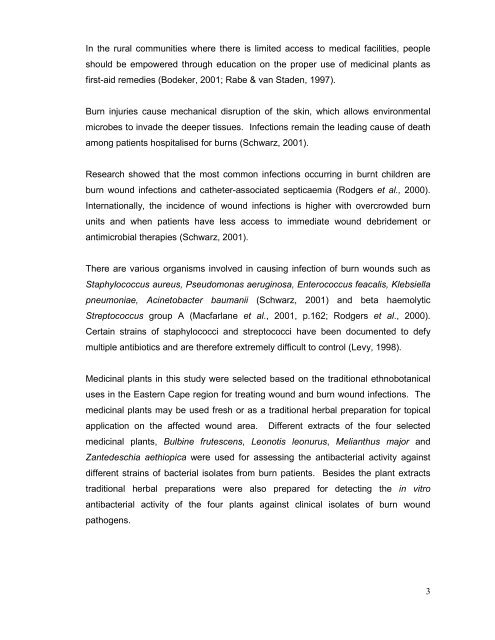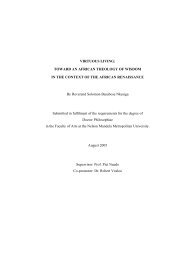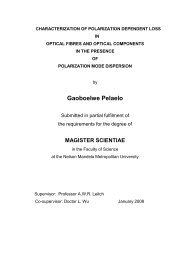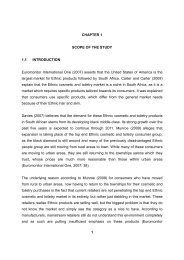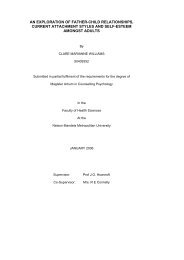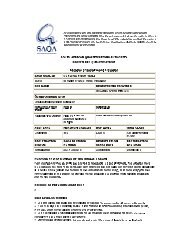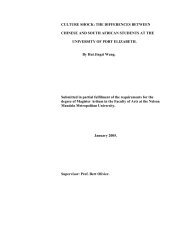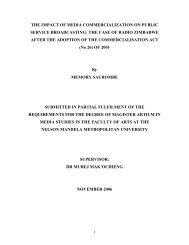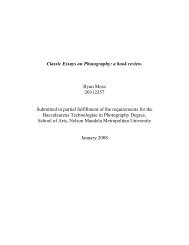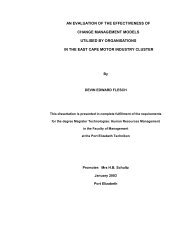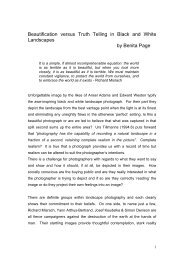an investigation into the antibacterial activities of medicinal plants ...
an investigation into the antibacterial activities of medicinal plants ...
an investigation into the antibacterial activities of medicinal plants ...
You also want an ePaper? Increase the reach of your titles
YUMPU automatically turns print PDFs into web optimized ePapers that Google loves.
In <strong>the</strong> rural communities where <strong>the</strong>re is limited access to medical facilities, people<br />
should be empowered through education on <strong>the</strong> proper use <strong>of</strong> <strong>medicinal</strong> pl<strong>an</strong>ts as<br />
first-aid remedies (Bodeker, 2001; Rabe & v<strong>an</strong> Staden, 1997).<br />
Burn injuries cause mech<strong>an</strong>ical disruption <strong>of</strong> <strong>the</strong> skin, which allows environmental<br />
microbes to invade <strong>the</strong> deeper tissues. Infections remain <strong>the</strong> leading cause <strong>of</strong> death<br />
among patients hospitalised for burns (Schwarz, 2001).<br />
Research showed that <strong>the</strong> most common infections occurring in burnt children are<br />
burn wound infections <strong>an</strong>d ca<strong>the</strong>ter-associated septicaemia (Rodgers et al., 2000).<br />
Internationally, <strong>the</strong> incidence <strong>of</strong> wound infections is higher with overcrowded burn<br />
units <strong>an</strong>d when patients have less access to immediate wound debridement or<br />
<strong>an</strong>timicrobial <strong>the</strong>rapies (Schwarz, 2001).<br />
There are various org<strong>an</strong>isms involved in causing infection <strong>of</strong> burn wounds such as<br />
Staphylococcus aureus, Pseudomonas aeruginosa, Enterococcus feacalis, Klebsiella<br />
pneumoniae, Acinetobacter baum<strong>an</strong>ii (Schwarz, 2001) <strong>an</strong>d beta haemolytic<br />
Streptococcus group A (Macfarl<strong>an</strong>e et al., 2001, p.162; Rodgers et al., 2000).<br />
Certain strains <strong>of</strong> staphylococci <strong>an</strong>d streptococci have been documented to defy<br />
multiple <strong>an</strong>tibiotics <strong>an</strong>d are <strong>the</strong>refore extremely difficult to control (Levy, 1998).<br />
Medicinal pl<strong>an</strong>ts in this study were selected based on <strong>the</strong> traditional ethnobot<strong>an</strong>ical<br />
uses in <strong>the</strong> Eastern Cape region for treating wound <strong>an</strong>d burn wound infections. The<br />
<strong>medicinal</strong> pl<strong>an</strong>ts may be used fresh or as a traditional herbal preparation for topical<br />
application on <strong>the</strong> affected wound area. Different extracts <strong>of</strong> <strong>the</strong> four selected<br />
<strong>medicinal</strong> pl<strong>an</strong>ts, Bulbine frutescens, Leonotis leonurus, Meli<strong>an</strong>thus major <strong>an</strong>d<br />
Z<strong>an</strong>tedeschia aethiopica were used for assessing <strong>the</strong> <strong>an</strong>tibacterial activity against<br />
different strains <strong>of</strong> bacterial isolates from burn patients. Besides <strong>the</strong> pl<strong>an</strong>t extracts<br />
traditional herbal preparations were also prepared for detecting <strong>the</strong> in vitro<br />
<strong>an</strong>tibacterial activity <strong>of</strong> <strong>the</strong> four pl<strong>an</strong>ts against clinical isolates <strong>of</strong> burn wound<br />
pathogens.<br />
3


